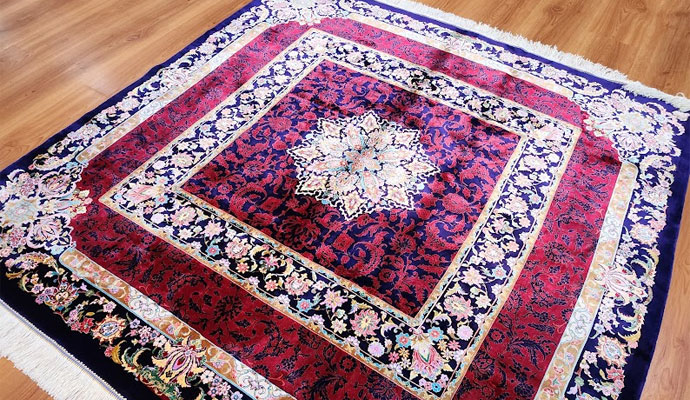Within 25 Miles of Green Brook
Within 25 Miles of Green Brook
Top Mistakes to Avoid When Handling Water Damage on Rugs
Water damage on rugs can be a frustrating and costly issue for homeowners. Whether caused by a burst pipe, flooding, or an accidental spill, water can quickly ruin a beautiful rug if not addressed properly. Beautiful rugs can truly elevate a room's décor, adding warmth, texture, and a touch of personality. But what happens when disaster strikes and your beloved rug suffers from water damage? While a drenched rug might seem like a lost cause, taking swift action and avoiding common mistakes can significantly increase your chances of salvaging your cherished piece. In this comprehensive guide, we'll delve into the top mistakes to avoid when handling water damage on rugs, equipping you with the knowledge to act effectively and minimize the harm.

1. Understanding Water Damage on Rugs
Water damage on rugs can result from a variety of sources, such as leaking pipes, flooding, or accidental spills. When rugs come into contact with water, they can suffer from mold and mildew growth, color bleeding, and fiber damage. Mold and mildew thrive in moist environments, posing health risks and further deteriorating the rug. Additionally, water can cause dyes to bleed, leading to discoloration and a loss of the rug's original beauty. Prolonged water exposure weakens the rug fibers, making them more prone to tearing and wear. Understanding these effects is crucial for addressing water damage promptly and effectively.
2 . Common Causes of Water Damage on Rugs
- Leaking Pipes: A common culprit of water damage in homes. When pipes leak or burst, the water can seep into rugs and cause significant damage.
- Flooding: Natural disasters or plumbing issues can lead to flooding, which can saturate rugs with water.
- Spills and Accidents: Everyday accidents, such as spilling a drink, can also result in water damage if not cleaned up promptly.
3. Effects of Water Damage on Rugs
Water damage can lead to various problems for rugs, including:
- Mold and Mildew Growth: Moisture creates an ideal environment for mold and mildew, which can cause health issues and further damage the rug.
- Color Bleeding: Water can cause dyes to bleed, resulting in discoloration and ruining the rug’s appearance.
- Fiber Damage: Prolonged exposure to water can weaken the fibers, making the rug more susceptible to tearing and wear.
Top Mistakes to Avoid When Handling Water Damage on your Rugs
Avoiding common mistakes can help you effectively manage water damage and save your rugs from irreversible damage.
1. Ignoring the Problem
One of the biggest mistakes is ignoring the water damage. Even a small amount of water can cause significant damage if left unattended. It’s crucial to act quickly to prevent the growth of mold and mildew and further damage to the rug fibers.
What to Do InsteadAs soon as you notice water damage, take immediate action. Blot the area with clean towels to remove as much water as possible. If the rug is heavily saturated, consider using a wet/dry vacuum to extract the water.
2. Using the Wrong Cleaning Products
Using the wrong cleaning products can exacerbate the problem. Harsh chemicals can damage the rug fibers and dyes, causing more harm than good.
What to Do InsteadChoose cleaning products specifically designed for rugs. Avoid bleach and other harsh chemicals. If you’re unsure, consult a professional rug cleaner for advice on the best products to use.
3. Not Drying the Rug Properly
Failing to dry the rug thoroughly can lead to mold and mildew growth, which can ruin the rug and pose health risks.
What to Do InsteadAfter removing as much water as possible, place the rug in a well-ventilated area to dry. Use fans and dehumidifiers to speed up the drying process. Avoid placing the rug in direct sunlight, as this can cause fading.
4. Overlooking the Padding
Rug padding often gets overlooked when dealing with water damage. Ignoring the padding can lead to persistent moisture problems.
What to Do InsteadCheck the padding underneath the rug for water damage. If the padding is wet, remove and replace it to prevent mold and mildew growth.
5. Not Seeking Professional Help
Attempting to handle severe water damage on your own can lead to further damage and higher costs in the long run.
What to Do InsteadFor extensive water damage, it’s best to seek professional help. Professional rug cleaners have the expertise and equipment to thoroughly clean and dry your rug, preventing further damage.
Preventing Water Damage on Rugs
Preventing water damage is always better than dealing with the aftermath. Here are some tips to help you protect your rugs from water damage.
1. Regular Maintenance
Regular maintenance can help you identify and address potential issues before they become major problems. Inspect your plumbing and roof regularly for leaks and make necessary repairs promptly.
2. Use Rug Pads
Using rug pads can provide an extra layer of protection against water damage. They can help prevent moisture from seeping into the rug and provide additional cushioning.
3. Quick Response to Spills
Responding quickly to spills can prevent water from penetrating deep into the rug fibers. Blot spills immediately with a clean towel to absorb as much liquid as possible.
4. Elevate Rugs in Flood-Prone Areas
If you live in an area prone to flooding, consider elevating your rugs off the floor. Using furniture risers or other methods to keep rugs off the ground can prevent water damage during floods.
Conclusion
Water damage on rugs can be a challenging issue, but by avoiding common mistakes and taking preventative measures, you can protect your rugs and maintain their beauty. Act quickly, use the right cleaning products, ensure proper drying, and seek professional help when needed. With these tips, you can effectively handle water damage on rugs and keep your home looking its best. Water damage on rugs can be a daunting issue, but understanding its causes and effects is the first step toward effective management. Mold growth, color bleeding, and fiber damage can all compromise the beauty and longevity of your rugs. To protect your investment and ensure a thorough restoration, prompt and professional intervention is key. For residents of New Jersey, our expert rug cleaning services provide the perfect solution. Don't let water damage ruin your precious rugs — Contact Rugs Cleaning New Jersey today for a comprehensive and professional cleaning service. Restore your rugs to their original glory and maintain a healthy home environment by calling us now!


